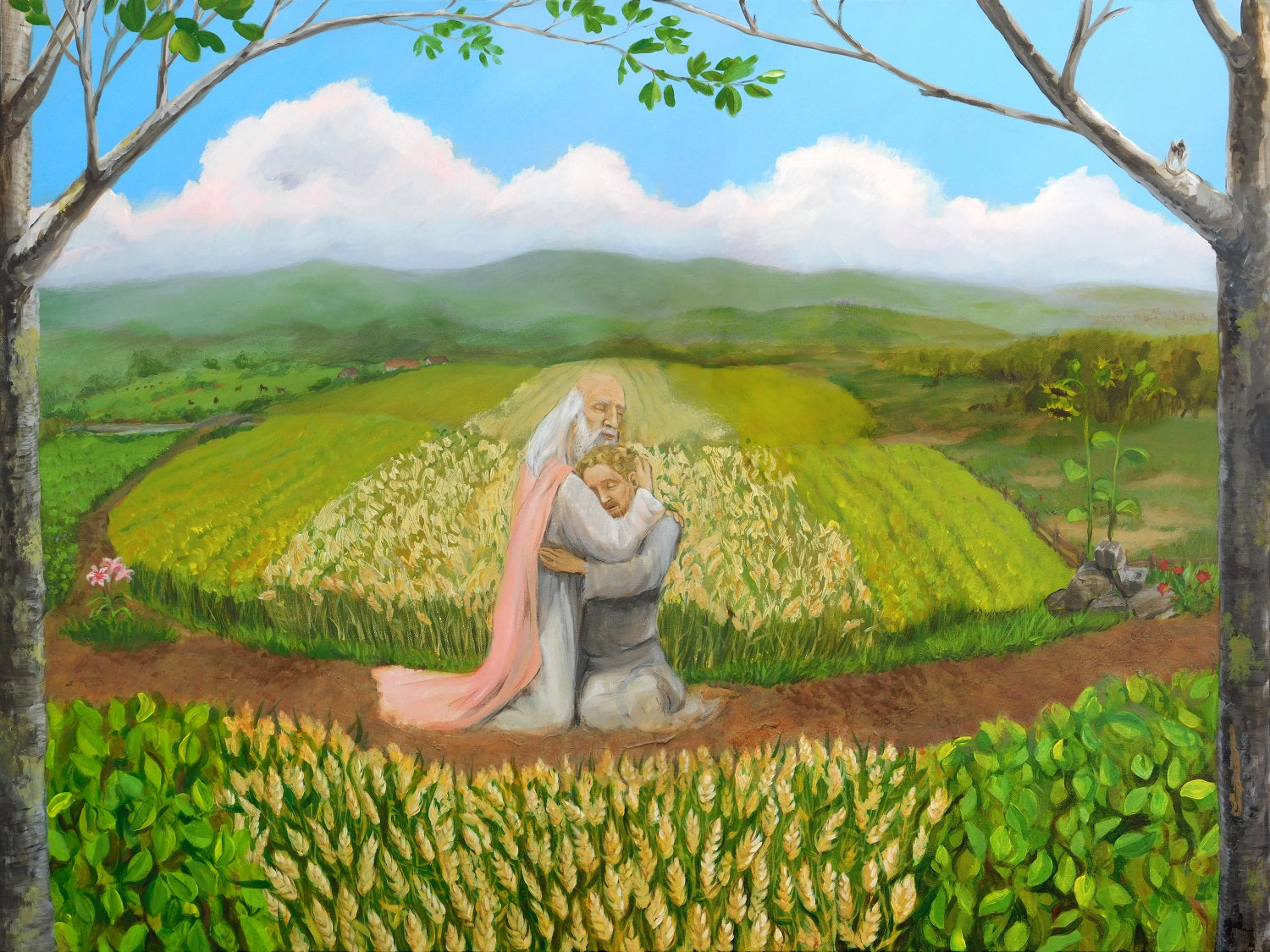The Prodigal Son Returns, acrylic on canvas, 48" x 36"
Buy Now
One of my favorite paintings to date is called "The Prodigal Son Returns."
I started my version many years ago in a sketch which I made during a long drive to visit a friend.

As you can see, I originally included an image of the elder brother who appears at the end of the original tale. I've also got a few notes scribbled in the corner. From the beginning, I imagined the younger son's face as "enervated" yet "cherubic."
And there the sketch sat, waiting for me to finally paint it.
And as the painting slowly took form in my mind (and nagged me to get started) I began to think of friends and family who have been tragically lost to drug addiction. Their lives often become so intolerable that we're forced to put up barriers between us and them, and yet the hope always lingers that some day, somehow, they will be able to return to our lives.
And sometimes they do. But by then, even if they are young, there remains a wasted and haunted look in their eyes.

The 12 Symbols of the Return of the Prodigal Son
In my painting, the young man still has the golden curls of youth, but his hands are thin and bony, and his face is wasted and sorrowful. Contrasted with him is the sturdy build of the Father, whose face is gently aged by time.
The son is barefoot, symbolizing his humility and repentance. I feel that he is my stand-in in this painting, my spiritual portrait, because I myself have made so many mistakes and still have to repent to God all the time.
And yet the Father has gone down on his knees in the mud, not stinting at the filth and rags his son is wearing, but embracing him in love and complete forgiveness. (I cherish a photo of my own father wearing a similar expression at my wedding, as he hugs me at the reception.)
All around them are the waves of the wheatfield, which serves as a halo to show that this is a sacred moment. It also symbolizes the Eucharist, the Bread of Life, or the Body of Christ depending on how you want to think of it.

As we spread out from the two central figures, we begin to see a theme that divides the world into two. On one side is the bountiful land of Home or Heaven, the place that our hearts enter when we draw near to God the Father.
For example, there are two trees framing the picture. Part of their purpose is to "frame" the story much like the curtains in a theater will frame a stage, to show that this is a parable told by Jesus.

The right-hand tree is dead, indicating the death or sickness that we feel when we're apart from God. (And the death and sickness that scourge our land due to the opiate crisis.)
The tree on the left is a living sassafras tree, a species which grows here in Appalachia. The new leaves of the sassafras can be eaten and have a light, sweet flavor which symbolizes the sweetness of repentance.
The left side also shows a few details deeper in the background:

First you can see the lily, which stands for the resurrection of Christ, and by extension the resurrection of our own souls. Then behind that is a little field of clover, which is a very rich food for animals, indicating the richness of our Christian lives.
Deeper beyond is well-watered land, with a little stream running through it. There are rolling hills with fat cattle, and the red roofs of Home.
Compare this with the land on the other side of the picture:

At the bottom of this detail you can see a pile of stones, which indicates the boundary markers the son passed when he left home. Sprouting up out of these is a bunch of sunflowers.
Sunflowers can have many meanings, but classically they stand for foolishness and wandering, because their flowerheads seem to foolishly track the sun during the day.
Next to the sunflowers, and dotted in the land beyond, are red poppies which are the source of opium and stand for addiction. And the land beyond is also barren, desolate, and wasted: a symbol of what we experience when we stray from our home with God.
So to recap, here are the twelve symbols:
- Bare feet
- Halo of wheat
- Dead tree
- Sweet sassafras tree
- Beautiful lilies
- Rich clover
- Abundant creek
- Fat cattle
- Foolish sunflowers
- Deadly poppies
- Barren fields
- The storm rolling away
I haven't mentioned the storm, but if you look in the background you can see the clouds rolling away. That's how it feels to finally be welcomed back into the arms of the Father. Our worst troubles are past, because we have a Friend in times of trouble.

What Does the Parable of the Prodigal Son Mean?
The real meaning of the story (and the painting) is this:
I hope you've found inspiration from this post. If you have, please consider buying a piece of art to keep as a reminder of the mercy of God.
The original of this painting is in a private collection, but you can buy a large, full-color, archival-quality print for your home here:
Buy Now





